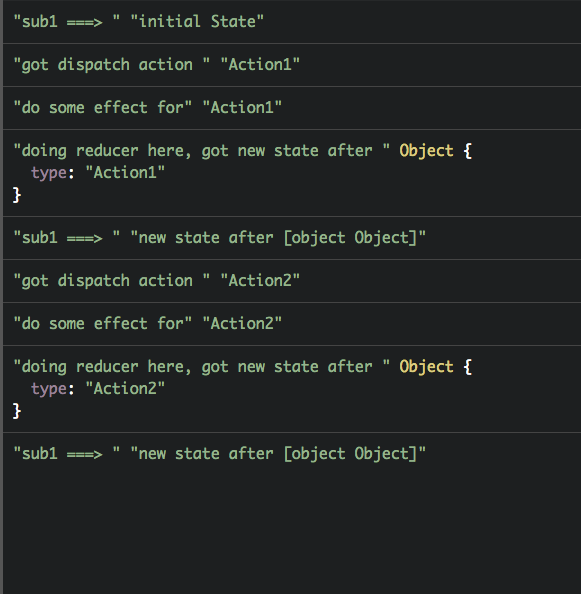繼續往下做整個 Store 之前,我們先來想一下整個 Store 的架構跟資料流
當元件 (component) 或是 Store 自己內部分派一個 (dispatch) Action 時, Dispatcher 接住這個 Action,交給 Reducer (或者交給 Effect) ,Reducer使用前一個 State 處理這個 Action,產生新的 State,然後 push 給訂閱者 (Subscriber)
來看程式
interface Action {
type: string;
payload?: any
}
class Dispatcher extends Rx.Subject<Action> {
dispatch(act) {
console.log('got dispatch action ', act.type);
this.next(act);
}
}
class Store extends Rx.BehaviorSubject<Action>{
constructor(private dispatcher, initialState) {
super(initialState);
this.dispatcher
.do((v) => { console.log('do some effect for', v.type)})
.do((v) => { console.log('doing reducer here, got new state after ', v)})
.subscribe(state => {
super.next('new state after ' + state); // new state, push to subscriber
});
}
dispatch(act) { // delegate to dispatcher
this.dispatcher.dispatch(act);
}
// override next to allow store subscribe action$
next(act) {
this.dispatcher.dispatch(act);
}
}
// instanciate new store
const dispatcher = new Dispatcher();
const store = new Store(dispatcher, 'initial State');
// add subscriber
const sub1 = store.subscribe(v => console.log('sub1 ===> ', v));
// start dispatch action
store.dispatch({type: 'Action1'}); // dispatch new action to store
store.dispatch({type: 'Action2'}); // dispatch another action
dispatcher。dispatcher 跟 initial state 用參數傳入 Store 的 constructor 中,因為 Store 是 BehaviorSubject 一定要在 constructor 中傳入 。dispatch method 攤派 (delegate) 給 dispatcher,以後傳入的 Action 就會進入 dispatcher的 dispatch,而dispatch 用 dispatcher 的 next 來導入下一個 Action,因為 dispatcher是 subject。constructor 讓 dispatcher 開始加工,這裡先用 .do() 預留給 effect 跟reducer,後面我們再來詳細說明 reducer 如何作用。reducer後可以用 subscribe 帶出 reducer 產生新的狀態,留在 Store 的 BehaviorSubject 中,這時外面的 subscriber 就會得到新的狀態。store.dispatch({type: 'Action1'})。上面程式會產生
這個程式就是整個 Store 的大架構,程式相當精簡因為用了 Subject 跟 BehaviorSubject,它們提供了我們需要基礎的功能,例如接下一個 Action, dispatcher 中間的加工應用了 Observable 的 Operators。
接下來我們要開始來做 Reducer了,上面的程式還沒使用到狀態,接下來的 Reducer 將會就目前的狀態跟新的 Action 結合產生出新的狀態。
